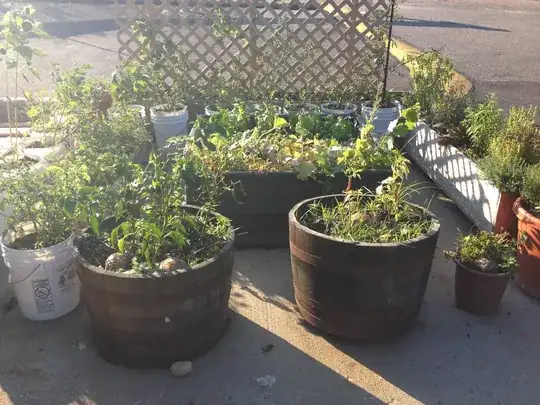You're probably right, the containers are being baked by hot sun, especially standing on hard surfacing like concrete, which holds the heat. Some remedial arrangement of the containers would certainly help; moving them close together, or as close as possible, or grouping them, so that the plants have sufficient room with good air circulation, but are close with other plants, helps because the transpiration of each plant helps with the one next to it, creating a bit less moisture loss.
The other thing I'd suggest is that the containers are stood on something which raises them slightly off the concrete, enabling air to circulate beneath. Just an inch or so will do it,though it doesn't matter if its more, and will create better drainage conditions. Because the next thing to recommend is a good soaking with water, directly onto the compost/soil in the pots, not on the plants themselves, morning and evening when the weather is hot, and a hosing down of the concrete during the middle of the day to cool the hard surface down, more often if possible. This advice obviously assumes that the containers do have drainage holes which are not blocked. Feeding should obviously still take place, but not necessarily every time watering is carried out.
The situation you describe should be fine for eggplants, peppers and tomatoes - the heat will certainly be good for ripening fruit - but ensuring a good water supply is critical. Given that temperatures may be too high at times, some sort of shading which can be erected when necessary, and removed when it's not, would be a good idea too. Perhaps erected during very hot weather between the hours of 11 to 3, being removed outside of those hours. Whether this needs to be a permanent structure like a pergola, over which is drawn some tenting or similar material, when its appropriate, or whether several garden umbrellas might do the trick is for them to decide.
I'm not sure I'd recommend the straw around the containers, frankly - straw holds heat too.
Ongoing, it will be necessary to renew the soil in the containers periodically, depending on the crops being grown. Most herbs will be fine in the same soil for a long time, but crops like solanums can develop soil pests, so occasional soil change may be necessary.
UPDATE 30 August: Now I've seen the photo, the other advice I'd offer is to get better containers - ones that are a minimum of 18 inches deep and as wide as possible. Squares or oblongs will 'fit' together better too. The larger the containers, the better the plants will grow, and they'll dry out less quickly too. Trying to water that disparate array of small 'pots' must be a real pain - I can't even tell what's growing in them currently. Some of them appear to be buckets which, unless someone has drilled holes, don't have drainage. I'm also wondering what they'll do with the compost/soil when it needs to be changed...
